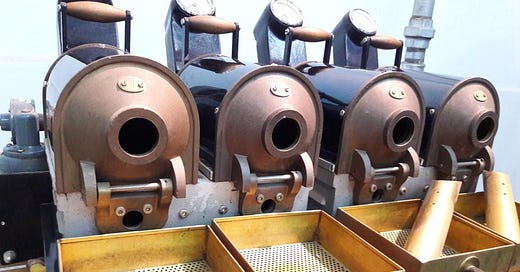This is more of an apology to the Ikawa team, London coffee festival circa 2016. When a relatively young(ish), naive and pretty persistent coffee novice was asking all the wrong questions. For their patience, I will be forever grateful.
To select a truly great coffee you first have to sample roast, to understand a coffee’s potential for quality you first have to sample roast, to provide the necessary feedback on a coffee you first have to sample roast, you get my point. Sample roasting is a crucial step in a coffee’s journey however, the main objective as the name suggests, Is to sample.
This is what I got wrong, my pursuit of roasting delicious coffee got me all caught up in trying to figure out a way to replicate my sample roasts and apply this to a commercial roaster. I was adamant that if I was going to invest a few thousand pounds of company money then I would need a sample roaster that would allow me to create the perfect roast and then exactly replicate this somehow on a commercial scale. Seems like a logical ask you would think? Well, nothing could be further from the truth.
Sample roasting is nothing like commercial roasting and vice versa, to truly understand the objective of a good sample roast you first have to identify the intended purpose, of which there are a few.
Grading coffee.
Green coffee that is sent via CQI or an ICP and roasted to protocol with absolutely no roast defects in order to evaluate the cup score. This evaluation will be the deciding factor as to whether or not the coffee meets specialty standards. This will be carried out by 3 independent licensed Q Arabica graders, be carried out blind and then the results will be submitted to the QCI database. Most of the time the grader will not find out anything about the coffee, apart from the score.Pre-shipment and landed sample assessment.
Coffee is sent to importers or direct to roasters as green samples to be evaluated at two main stages. PSS will be sent sometime during the main harvest period to gain an insight into the current harvest quality, if the coffee is then contracted and shipped there will be a secondary evaluation of the coffee once it lands on the shores of the contracted country. hopefully, the two samples will cup at a similar quality and be approved. In my experience quality coffee tends to improve slightly from the PSS as the coffee has had time to lose a little of its ripeness which can tend to be slightly grassy when fresh.
Inventory selection.
Green coffee samples are sent by producers or importers to the roaster with the sole purpose of evaluating the coffee’s attributes and then selecting for the roaster’s inventory. Coffee can come from a single producer and be broken down into smaller lots, it can be coffee from a single wet mill or beneficio and the lots can be separated in a number of ways, from a single farmer to a specific area, or it can be a regional blend of coffees from a particular country. Coffee can be broken down even further into even smaller lots focusing on a particular variety or screen size or it can be one mixed lot depending on what the coffee’s purpose is. This evaluation will be more personal to the roasters’ preference and price point and will be selected to fit a certain category which they know will work for their clients.

My objective…
I already know what I want from my coffee. I prefer balanced qualities with a big juicy mouthfeel. I prefer coffees where all of the qualities work in harmony together with no single attribute shouting too loud in the cup. I also know what quality tastes like and detecting defects is a crucial skill. I know I can quiet things down on the commercial roaster but if the quality isn’t there in the first place, then no amount of wizardry will turn a bad coffee into a good one.
My theory for sample roasting is this:
Light, fast, and well-developed.
I want to see what the coffee has to offer at its most vulnerable, I don’t want to mask it with under or overdeveloped flavours and I want to give it a chance to show its true self. My main aim is to understand what the coffee has available for me to work with. A decade of roasting coffee has allowed me to build the skills needed to know that I can reduce acidity if needed and develop the coffee for more body, but sample roasting is just that, it is a sample, a brief moment for you to interact with the coffee and get to know it a little. Don’t overthink it and learn to understand that if it scores high it is because it has quality. Your main aim is to do it justice and not screw it up.
I use one profile for every coffee I sample. I use the IKAWA pro 50 and this has served me well for many years. LONG MILES COFFEE
The IKAWA is a great tool and there will be a profile that works for you.
Burts






This is so informative & interesting to read. Thank you for sharing.